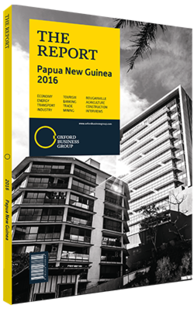Mobile banking products help rural Papua New Guinea
Financial institutions are making small but significant moves that are helping the sector to evolve incrementally. To a great extent, the changes revolve around branch expansion and the reach within the community. Westpac Bank currently has 16 branches around the country, while the Australia and New Zealand Banking Group (ANZ) has 12. Bank South Pacific (BSP) has 44 branches and 44 BSP Rural branches. The banks have said that they are typically not interested in opening new outlets, as it is expensive and does not necessarily generate the returns that would justify the investment – although in 2015 BSP established a presence in Higaturu, Northern Province to service the palm oil producers and their workers.
Leapfrogging
Instead, the banks have committed to expanding their footprints via other channels and improving productivity. Each of the major banks offers its own mobile product: ANZ has goMoney, which was introduced to PNG, Solomon Islands and Samoa in 2013 and to Vanuatu in 2014; Westpac and BSP both have products branded as Mobile Banking; and Nationwide Microbank has MiCash. These products have allowed customers to conduct a wide range of transactions, including checking balances and transferring funds, while cash-in and cash-out transactions are possible at trade stores and other establishments connected to the network. BSP also has Wantok Moni, a cell-based service for those without a bank account. By utilising these innovative solutions, banks in PNG hope to extend their reach, especially to remote areas. “An important part of expanding the financial system is through technology and mobile banking,” Mark Baker, managing director PNG at ANZ Banking Group, told OBG. “But how do you expand that in a cost-effective manner? It is about channel development in retail, not about building branches, because that is not sustainable in the long term.”
Baker added that branches in PNG are very different from those in other countries in terms of how they are utilised. There are fewer outlets for retail investors and more points of contact for small businesses and for commercial establishments, so while secondary cities may not be home to many individual customers, branches are still needed there for businesses to deposit their cash and for the banks to service these clients. He also noted that the transition to mobile is likely to be relatively quick and smooth, at least for those already on the financial grid, given the timing and the uptake of technology. “PNG will leapfrog technology. If you look at countries like the UK, they went from branches to call centres to internet to mobile,” Baker told OBG. “In PNG call centres did not really work, and internet banking has never really taken off. It has gone straight to mobile, and it is now about consolidating that channel.”
More Throughput
For BSP the focus is on getting more out of their physical assets. The bank, which has the most branches in the country, has a public obligation to operate in all provinces. However, the bank is finding that many of these locations fail to generate sufficient revenue, and some may even be losing money. The goal is now to get more business done at those under-performing locations.
One way to increase the throughput at these sites is to increase the number of small companies that are serviced. With that in mind, BSP has been working to give more loans to businesses with annual turnover of less than PGK3m ($1m). Its Smart Business programme seeks to get smaller enterprises banked so that after 12 months they can borrow from PGK5000 ($1710) to PGK250,000 ($85,300) without need for a formal financial statement. The bank is also developing its LendFast product, an automated system that allows individuals to take unsecured loans of up to PGK50,000 ($17,100). “The branch network has historically been seen as a drag on profitability,” Robin Fleming, CEO of BSP, told OBG. “The overall strategy is to try to get more business through our branches.”
You have reached the limit of premium articles you can view for free.
Choose from the options below to purchase print or digital editions of our Reports. You can also purchase a website subscription giving you unlimited access to all of our Reports online for 12 months.
If you have already purchased this Report or have a website subscription, please login to continue.


